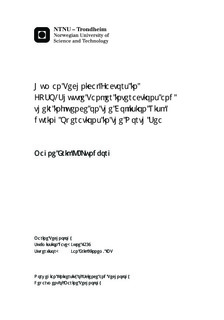| dc.description.abstract | Following a series of collisions and near-misses, involving shuttle tanker and FPSO performing tandem offloading operations in the North Sea, extensive effort was put to address the issue in the early 2000 s. The aim of this thesis is to investigate the current situation for risks relating to collisions between DP shuttle tanker and FPSO during tandem offloading operations in the North Sea. The main research question was what major research has been performed on the collision risk between DP shuttle tanker and FPSO during tandem offloading in the North Sea, and what is the current situation of the collision risk, anno mid 2014? An extensive literature study was performed, featuring background material concerning FPSOs, shuttle tankers, and tandem offloading operations. The collision risk was further investigated by using both qualitative and quantitative risk analysis methods. The qualitative risk analysis included an assessment of human, organisational, and technical factors influence in tandem offloading operations. Based on the aforementioned, a simple analysis of barriers against collision in a drive-off scenario was performed using the bow-tie method. The quantitative risk analysis included a statistical data analysis of reported incidents involving DP shuttle tankers performing tandem offloading from FPSOs on the UK and Norwegian continental shelves (UKCS & NCS), covering the time period from 1995-2013. The results from the risk analysis were further applied to propose possible risk mitigation measures for tandem offloading operations between DP shuttle tanker and FPSO.Research relating to the collision risk in FPSO-shuttle tanker offloading operations, performed post the conclusion of the JIP project Operational Safety of FPSOs , is found to be mainly concerned with further work regarding the risk elements that were identified in the JIP project and the PhD thesis of Dr. Ing. Haibo Chen, as well as providing updated statistics on incidents and risk levels.Results from this thesis risk analysis revealed a decrease in the frequency (both absolute and per offloading) of incidents and collisions, during FPSO-shuttle tanker offloading operations on the UKCS & NCS, when comparing 1995-2003 versus 2004-2013. For the UKCS & NCS aggregated, per mid-2014, the collision frequency estimated to lie in the range of 4.5E-04 to 8.0E-04 per offloading, and the drive-off frequency is estimated to lie in the range of 9.0E-04 to 2.3E-03 per offloading.Several measures for reducing the collision frequency have been proposed and discussed in this thesis. The measures addresses DPO competence level, time available for initiating recovery action, cooperation between shuttle tanker and FPSO, and alternative field configurations. The collision frequency can be significantly reduced by applying direct offloading configuration instead of tandem offloading configuration. However, there are technical and operational issues that have to be resolved, before applying such a configuration to ship-shaped FPSOs | nb_NO |

